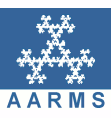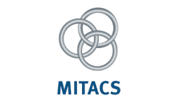 |
|
||||
Org: Alex Karassev (Nipissing), Gábor Lukács (Manitoba) et Paul Szeptycki (York)
[PDF]
- MAX BURKE, Department of Mathematics and Statistics, University of Prince Edward Island, Charlottetown, PE, C1A 4P3
Large cross sections through sets in Euclidean spaces [PDF] -
We consider sets A Í Rn ×R which are large either in the sense that their complement either does not contains a Borel set of positive measure or does not contains a nonmeager Borel set. We survey theorems and open problems concerning the existence for such a large set A of cross sections of the form fÇA, where f: Rn ® R, which are large relative to f (in a suitable sense) and where f is as nice as possible, for example constant (as in Fubini's theorem) or continuous or smooth or entire.
- TADEUSZ DOBROWOLSKI, Pittsburg State University
Refining the Linear Structure of non-AR Linear Space [PDF] -
The title refers to Cauty's example of a metric linear space C which is not an absolute retract. The Cauty's construction can be improved to the effect that the completion E of such a space C can be isomorphically embedded as a linear subspace of an F-space which itself is an absolute retract.
- A. DOW, UNC Charlotte
Countable spaces and connectifications [PDF] -
Which countable spaces have a connected compactification? Interest in this topic began with van Douwen's 1981 result that there is a Tychonoff nowhere locally compact space with no connected compactification. Also Emeryk and Kulpa verified van Douwen's conjecture that the Sorgenfrey line was such a space. Gruenhage et al. established that all metrizable nowhere locally compact spaces have a connected compactification while Alas et al. established a slightly stronger result in the separable case (which Gruenhage et al. showed did not hold in the general case). In this work we consider simple one-point extensions of the rationals and the main result is to show that there is one which does not have a connected compactification.
This is joint work with Vladimir Tkachuk.
- STEFAN GESCHKE, Hausdorff Center for Mathematics, Endenicher Allee 62, 53115 Bonn, Germany
A forcing dichotomy for closed graphs on Polish spaces [PDF] -
We show that a closed graph on a Polish space without large cliques has a small weak Borel chromatic number in some forcing extension of the universe. Here the weak Borel chromatic number of a graph is the least size of a partition of the vertex set into Borel sets that contain at most one vertex of every edge of the graph.
This is joint work with Ben Miller and Clinton Conley.
- SALVADOR HERNANDEZ, Universitat Jaume I
Duality methods in topological abelian groups [PDF] -
We report on some results around the duality theory of topological abelian groups. In particular, the properties of determined groups and the application of duality methods in the computation of some topological invariant cardinals will be mainly discussed.
This is a joint research with María V. Ferrer. A part of this talk also concerns several research projects accomplished with different authors: C. Chis, S. Macario, J. Trigos-Arrieta, and B. Tsaban.
- NEIL HINDMAN, Howard University, Washington, DC 20059, USA
An elementary proof that commutative semigroups satisfy the strong Folner condition [PDF] -
Let (S,·) be a semigroup and let Pf (S) be the set of finite nonempty subsets of S. Then S satisfies the Følner condition (FC) if and only if
Also S satisfies the strong Følner condition (SFC) if and only ifæ
è"F Î Pf (S) ö
ø("e > 0) æ
è$K Î Pf (S) ö
ø("s Î F) (|sK \K| < e·|K|).
Any semigroup satisfying SFC has a natural notion of density which is intimately related with the algebraic structure of the Stone-Cech compactification bS of S.æ
è"F Î Pf (S) ö
ø("e > 0) æ
è$K Î Pf (S) ö
ø("s Î F) (|K\sK| < e·|K|). Følner showed that any amenable group satisfies FC and Frey showed that any left amenable semigroups satisfies FC. Argabright and Wilde showed that any semigroup satisfying SFC is left amenable. They also showed that any commutative semigroup satisfies SFC. However their proof of the latter fact relied on the fact that any commutative semigroup is amenable, a fact whose proof is not particularly easy and is a bit hard to find, as well as the fact above that any amenable semigroup satisfies FC. We provide a simple elementarly (and entirely algebraic) proof that any commutative semigroup satisfies SFC.
- DAN KUCEROVSKY, University of New Brunswick
Weyl-von Neumann [PDF] -
We discuss some recent progress in Weyl-von Neumann theorems, in particular, applying beyond the usual case of corona C*-algebras.
- MATTHIAS SCHRÖDER, Universität der Bundeswehr München, Werner-Heisenberg-Weg 39,
85577 Neubiberg, Germany
Topology in Computable Analysis [PDF] -
Computable Analysis studies computability over the real numbers and related spaces. Since computable functions are continuous in a certain sense, topology plays an important role in this theory. The cartesian closed category QCB of quotients of countably based topological spaces turns out to be an appropriate category for modelling the topological aspects of higher type computation.
In this talk, we discuss topological properties of the Kleene-Kreisel continuous functionals and their surprising relationship to an open problem in exact real-number computation. We show that the sequential topology on the space N(NN), which is the space of Kleene-Kreisel continuous functionals of type 2, is neither zero-dimensional nor regular. Moreover, we establish non-regularity of further function spaces formed in the cartesian closed category of Hausdorff k-spaces. k-Haus is one of the categories from which QCB-Haus inherits its cartesian closed structure.
- JURIS STEPRANS, York University
Subgroups of the symmetric group on the integers [PDF] -
Some results and questions concerning subgroups of the full symmetric group of the integers are their natural action will be discussed.
- MURAT TUNCALI, Nipissing University
Remarks on Countable Rank Maps [PDF] -
Let f : X ® Y be a function and let m be an infinite cardinal. Then we say that the rank r(f) of f is £ m if
If m = À0 then f is of countable rank. In this talk, some results concerning projective classes of countable rank maps will be presented.ê
ê{y Î Y : |f-1(y)| > 1} ê
ê£ m. This is a joint work with Pawel Krupski (University of Wroclaw, Poland).
- ED TYMCHATYN, University of Saskatchewan
Extending Isotopies of Planar Continua [PDF] -
Let Z be a continuum in the plane and let h : Z ×[0,1] ® C be an isotopy starting at the identity. We prove that h extends to an isotopy of the plane. We provide a new characterization of an accessible point in Z and show that accessible points are preserved under the isotopy. We show next that the isotopy can be extended over small hyperbolic crosscuts which are shown to remain small under the isotopy. The proof makes use of the notion of a metric external ray which mimics the notion of a conformal external ray but which is easier to control under the isotopy. It also relies on the existence of a partition of a hyperbolic, simply connected domain U in the sphere into hyperbolically convex sets which have limited distortion under conformal maps to the unit disc.
- BEATRIZ ZAMORA-AVILES, York University
Gaps in the poset of projections of the Calkin Algebra [PDF] -
We study the gap structure of the partial order of projections of the Calkin algebra of a separable infinite dimensional Hilbert space. We prove the existence of an analytic Hausdorff gap in this partial order. As a consequence we obtain that under Todorcevic's Axiom and MA the gap spectrum of P ( C(H) ) is strictly bigger than the gap spectrum of P(w)/Fin.







